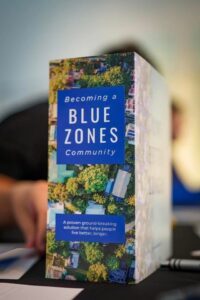Blue Zones in Miami Beach: How Your Business Can Benefit
 In February 2025, the City of Miami Beach launched a six-month Blue Zone assessment to explore how the city can be a healthier place to live, work and play. Blue Zones are geographic regions around the world where people live exceptionally long and healthy lives. The term was coined by Dan Buettner, a National Geographic explorer, after he identified five areas with a high concentration of centenarian (people living beyond 100 years). The Blue Zone team is in Miami Beach examining how the city can be enhanced by making lasting changes to the environment and health choices. Benefits include healthier population, increased economic growth, stronger community engagement, environmental advances, and enhanced quality of life.
In February 2025, the City of Miami Beach launched a six-month Blue Zone assessment to explore how the city can be a healthier place to live, work and play. Blue Zones are geographic regions around the world where people live exceptionally long and healthy lives. The term was coined by Dan Buettner, a National Geographic explorer, after he identified five areas with a high concentration of centenarian (people living beyond 100 years). The Blue Zone team is in Miami Beach examining how the city can be enhanced by making lasting changes to the environment and health choices. Benefits include healthier population, increased economic growth, stronger community engagement, environmental advances, and enhanced quality of life.
 "The Blue Zone initiative could be a catalyst for transformational change for the residents of our city," states Commissioner Tanya Bhatt, "By identifying and understanding the key factors that promote longevity and well-being, Miami Beach can develop strategies to improve health and lifespan.” Commissioner Tanya Bhatt aims to position Miami Beach as a model for health and wellness, stating, "Miami Beach can be an inspiration for individuals and communities to adopt healthier lifestyle choices.”
"The Blue Zone initiative could be a catalyst for transformational change for the residents of our city," states Commissioner Tanya Bhatt, "By identifying and understanding the key factors that promote longevity and well-being, Miami Beach can develop strategies to improve health and lifespan.” Commissioner Tanya Bhatt aims to position Miami Beach as a model for health and wellness, stating, "Miami Beach can be an inspiration for individuals and communities to adopt healthier lifestyle choices.”
The Blue Zone assessment includes a readiness assessment, which is a structured exploration to determine how Blue Zones can amplify the good work occurring in Miami Beach and leverage existing plans to lift and increase the well-being of all residents and stakeholders in the area. Kelsie Cajka, the Transformation Operations Director, of Blue Zones, shared how local businesses can benefit from Blue Zones strategies:
1. The original five Blue Zones are Icaria, Greece, Loma Linda, California, Sardinia, Italy, Okinawa, Japan, and Nicoya, Costa Rica. Which one do you think is most compatible with Miami Beach?
It is hard to compare the original Blue Zones to Miami Beach, but a common element is that the cities are walkable and embrace gardening in their daily lives. Compatible characteristics of Blue Zones, however, are high rates of physical activity, plant-based, nutrient-rich diets, strong social connections and community support, low stress levels, and a sense of purpose and spiritual engagement.
2. Currently how many Blue Zones are in the United States, and which have been successful?
There are currently 90 Blue Zones in the United States. Though each city has individual goals and initiatives, they embed Blue Zone principles and track their success with Gallup polls and measuring well-being, social initiatives and wealth. For example, one community might be focused on assisting businesses and another one may focus on becoming a more pedestrian friendly community. Salinas, California was introduced to Blue Zones in 2019, through the establishment of Blue Zones Project Monterey County. Over five years, the Salinas initiative expanded, resulting in a measurable reduction in chronic health risks, increased civic pride, and improvements in overall well-being. Salinas’ designation as a certified Blue Zones Community®, the first city to earn this designation in Monterey County, is an important milestone. The community’s overall well-being score improved by 5.9 points, from 61.7 to 67.6, representing a nearly 10% increase during a period in which many regions across the country experienced significant declines in well-being due to the global coronavirus pandemic.
3. How does a city become a Blue Zone?
A "Blue Zone" designation requires community-wide initiatives to foster healthy lifestyles, including policy changes, building design improvements, and promoting social networks, based on research from regions with the highest concentrations of centenarians and people with long lives. There are four main phases of Blue Zones designation: 1) identification, 2) exploration, 3) research, and 4) certification. This process usually takes up to 5-7 years.
4. How can Miami Beach businesses benefit from a Blue Zone designation?
The business community benefits from Blue Zone strategies which promote increased tourism and hospitality revenue, attraction of health-focused businesses and investment, reduced healthcare costs and increased productivity, stronger community ties and customer loyalty, and public support.
5. What are some of the challenges businesses or governments face when implementing a Blue Zone community?
Challenges are unique to each city, however, we have seen that though a business or a government implementing Blue Zone principals does so with good intention, challenges are real. There may be resistance to change, funding obstacles for healthier options and infrastructure improvements, and measuring and maintaining a long-term impact takes patience. However, the Blue Zone team believes being physically in the city, to implement the goals and initiatives of each community, is essential and helps navigate and solve perceived and real hurdles.
For additional information, please visit www.bluezones.com.